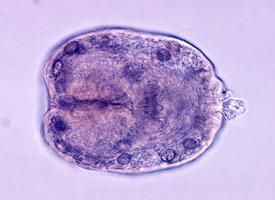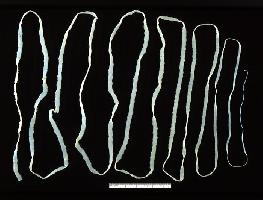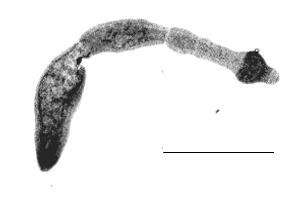
Súlyok és méretek
| Hossz | 3-tól 6-ig mm |
|---|
Veszélyeztetettség
| Rettenthetetlen |
Állatleírás
The Hydatid worm, scientifically known as Echinococcus granulosus, is a parasitic tapeworm that belongs to the class Cestoda in the phylum Platyhelminthes. This organism has a complex life cycle that involves two hosts: definitive and intermediate. The definitive hosts are typically canids such as dogs, wolves, and foxes, where the adult tapeworm resides in the small intestine. The intermediate hosts can be a wide range of ungulates (hoofed animals) and occasionally humans, in which the larval stage develops, causing the disease echinococcosis, also known as hydatid disease.E. granulosus is remarkably small compared to other tapeworms, with adults measuring only 3 to 6 mm in length. The adult worm consists of three segments: a head or scolex equipped with hooks and suckers for attachment to the intestinal wall of the definitive host, a short neck, and a series of three to four proglottids (body segments). The terminal segment is gravid and contains eggs, which are released into the environment through the feces of the definitive host.
The life cycle of E. granulosus is intriguing and complex. It begins when the eggs, containing the infective oncosphere larvae, are ingested by an intermediate host. Once inside the intermediate host's stomach, the eggs hatch, and the larvae penetrate the intestinal wall, entering the bloodstream. They are then transported to various organs, most commonly the liver and lungs, but they can also reach the brain, bones, and other tissues. Here, the larvae develop into hydatid cysts, a slow process that can take several years. These cysts are filled with fluid and contain numerous protoscoleces, which are essentially the heads of new tapeworms. If a definitive host preys on an infected intermediate host and ingests the cyst-containing organs, the protoscoleces attach to the intestine, developing into adult tapeworms, and the cycle continues.
Hydatid disease in humans and animals is a significant public health and economic concern, particularly in regions where livestock is closely associated with domestic dogs. In humans, the disease is characterized by the slow growth of cysts, which can cause a range of symptoms depending on their location and size, including abdominal pain, nausea, and even life-threatening complications if the cysts rupture.
Control and prevention of E. granulosus infection involve several strategies, including regular deworming of dogs, proper disposal of livestock offal to prevent dogs from accessing it, and public education on the risks of echinococcosis. In some regions, vaccines for sheep, one of the primary intermediate hosts, have been developed to reduce transmission.
In summary, the Hydatid worm, Echinococcus granulosus, is a small but significant parasitic tapeworm with a complex life cycle involving definitive and intermediate hosts. Its ability to cause serious disease in humans and animals makes it a focus of public health efforts in endemic areas.
Hasonló állatok
Új állatfotók
Top 10 állat
- Dolphin gull (Leucophaeus scoresbii)
- Diana monkey (Cercopithecus diana)
- Moustached guenon (Cercopithecus cephus)
- Galápagos tortoise (Geochelone nigra complex)
- Japanese macaque (Macaca fuscata)
- Russian tortoise (Testudo horsfieldii)
- Stone loach (Barbatula barbatula)
- Greek tortoise (Testudo graeca)
- Common flying dragon (Draco volans)
- Vendace (Coregonus albula)


